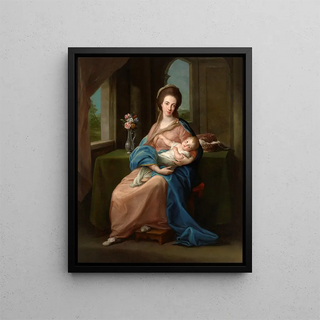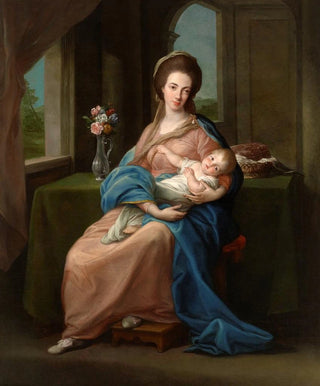Art print | Mary Taylour, Viscountess de Headfort, later Countess de Bective and Marchioness de Headfort - Pompeo Batoni


View from behind

Frame (optional)
Reproduction of Mary Taylour, Viscountess de Headfort, later Countess of Bective and Marchioness of Headfort - Pompeo Batoni – Captivating Introduction
The work of Pompeo Batoni, depicting Mary Taylour, Viscountess de Headfort, stands as a compelling testament to the elegance and refinement of the 18th century. This art print, which captures not only the face but also the soul of its model, transports us into a universe where nobility and art meet with unparalleled grace. Through the delicate features of Mary Taylour, Batoni manages to evoke a rare intimacy, while situating his subject within a frame of majesty. The composition, imbued with light and color, invites the viewer to contemplate the nuances of aristocratic life of the era, while revealing the personality of the woman standing before the artist.
Style and uniqueness of the art print
Batoni's style is characterized by striking realism, combined with a sensitivity to classical beauty. In this portrait, the meticulous details of Mary Taylour's clothing, adorned with delicate embroidery, contrast with the softness of her face. The colors, carefully chosen, create a visual harmony that captures the eye and the mind. The viscountess's posture, slightly turned, enhances the impression of movement and life, as if she is about to rise beyond the canvas. Batoni excels in the art of light, using subtle shadows to give relief and depth to his subject. This art print does not merely depict a woman of her time; it tells a story, that of an era where art and nobility intertwined to create timeless works.
The artist and his influence
Pompeo Batoni, a renowned Italian painter, established himself as a master of portraiture in the 18th century. Trained in classical traditions, he combined rigorous academic discipline with a more personal and expressive approach. His influence extends far beyond his contemporaries, impacting generations of artists who saw in him a role model to follow. By capturing the essence of his subjects with such precision, Batoni

Matte finish

View from behind

Frame (optional)
Reproduction of Mary Taylour, Viscountess de Headfort, later Countess of Bective and Marchioness of Headfort - Pompeo Batoni – Captivating Introduction
The work of Pompeo Batoni, depicting Mary Taylour, Viscountess de Headfort, stands as a compelling testament to the elegance and refinement of the 18th century. This art print, which captures not only the face but also the soul of its model, transports us into a universe where nobility and art meet with unparalleled grace. Through the delicate features of Mary Taylour, Batoni manages to evoke a rare intimacy, while situating his subject within a frame of majesty. The composition, imbued with light and color, invites the viewer to contemplate the nuances of aristocratic life of the era, while revealing the personality of the woman standing before the artist.
Style and uniqueness of the art print
Batoni's style is characterized by striking realism, combined with a sensitivity to classical beauty. In this portrait, the meticulous details of Mary Taylour's clothing, adorned with delicate embroidery, contrast with the softness of her face. The colors, carefully chosen, create a visual harmony that captures the eye and the mind. The viscountess's posture, slightly turned, enhances the impression of movement and life, as if she is about to rise beyond the canvas. Batoni excels in the art of light, using subtle shadows to give relief and depth to his subject. This art print does not merely depict a woman of her time; it tells a story, that of an era where art and nobility intertwined to create timeless works.
The artist and his influence
Pompeo Batoni, a renowned Italian painter, established himself as a master of portraiture in the 18th century. Trained in classical traditions, he combined rigorous academic discipline with a more personal and expressive approach. His influence extends far beyond his contemporaries, impacting generations of artists who saw in him a role model to follow. By capturing the essence of his subjects with such precision, Batoni






